During WWE's 2018 Superstar Shake-Up, Dolph Ziggler made his way back to RAW with some muscle in tow: recently dethroned NXT World Champion Drew McIntyre.
The ex-cheerleader and the Scot were met with skepticism at first, but their debut this past week against Titus Worldwide, featuring a spectacular tandem finisher and an even more fiery promo from McIntyre about his new career direction, turned those early guffaws into high expectations.
Ziggler has floundered basically since his exceptionally brief World Heavyweight Championship run; since then, his sporadic pushes have never amounted to much of anything, and his pairing with Drew McIntyre seemed more like an exasperated "hands in the air" maneuver by the company than anything else, an admission that they had nothing more for him, so why not form a tag team?
Will Ziggler and McIntyre join these teams, whose origins came from similar "we have nothing else for you" circumstances?
#10 Billy and Chuck
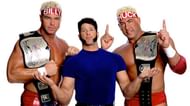
This won't be Billy Gunn's only appearance on the list, but Billy Gunn has a habit of shining in tag team situations while feeling incomplete in the singles scene. His botched 1999 King of the Ring win led to little more than a Rock squash, and was a simple speed bump between New Age Outlaws breakups and reformations.
Chuck Palumbo, meanwhile, was one of the best of a disappointing crop of WCW performers to come over in the lackluster InVasion angle, which is a bit like being the best player on the Cleveland Browns. Palumbo came in paired with Sean O'Haire, and the two found themselves split up in late 2001 and facing repackaging.
Palumbo and Gunn debuted late that year with matching bright red trunks, headbands, and bleach blonde locks, with constant insinuations that they were more than just tag team partners. Those insinuations only got broader with the addition of Rico to the entourage.
The gimmick was a nonstop gay joke, with WWE winking and nudging at the audience about whether or not Gunn and Palumbo were "just" tag team parters; their SmackDown wedding attracted all kinds of mainstream attention for possibly being a step forward in WWE's treatment of the LGBTQ+ community, but turned out to be just another wrestling angle (although one featuring one of the best-executed swerves of Eric Bischoff's career).
Regardless, the duo were successful, lasting approximately two years and spending four months of that time with two tag team title reigns; the gimmick may have been low-level comedy, but their wins were no laughing matter.
#9 Breezango
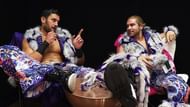
Breezango are unique on this list, as they are one of the only teams not to have won a championship once their slapdash gimmick got over.
Tyler Breeze was an NXT standout, but always seemed to be the guy to make other guys (much like Tye Dillinger, another man destined for a thrown-together team any day now). Breeze's losses to Finn Balor, Hideo Itami, and Jushin "Thunder" Liger were impressive in-ring showings where Breeze was little more than a pretty backdrop for his opponent's offense.
Fandango debuted in 2013 to massive fanfare, winning his WrestleMania debut in a shocking upset over Chris Jericho and quickly becoming his own wrestling meme, with his catchy theme song being the go-to chant for bored "smart" crowds.
Upon his main roster promotion during a confusing Lana-Rusev-Ziggler-Summer Rae love quadrangle, Breeze began to falter almost immediately after the story ended; he formed a sarcastic alliance with R-Truth in Truth's feud with former ally Goldust, and turned on Truth to join Goldust's partner, Fandango, in a heel pairing that lost to Golden Truth in the Money in the Bank pre-show blowoff (where Breeze and Fandango competed suffering from tanning bed-induced burns).
Breeze and Fandango began experimenting with a Fashion Police gimmick, writing tickets to "uggo" superstars and calling out fashion faux pas up and down the roster (while also being comedic punching bags for John Cena and Nikki Bella in the leadup to the "it" couple's WrestleMania mixed tag match).
Between WrestleMania 33 and its SmackDown followup show, Backlash, Breezango got both the freedom to improvise with their gimmick and some experienced sketch comedy writers to produce their backstage vignettes, leading to some of the most inspired comedy in pro wrestling history (being funny for being funny, without being unnecessarily cruel). Fashion Files buoyed Breezango to a tag team championship opportunity against the newly-heel Usos at Backlash, and made for one of the most entertaining matches on the show, coming up short despite numerous disguises and the use of janitorial equipment to slapstick ends.
Breezango are still comic relief on the main roster, but it's a comfortable spot for the duo and their highest-profile success to date, disproving Jim Cornette's mantra that "funny don't make money".
#8 Rusev DAY
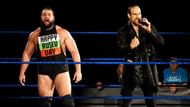
Rusev's undefeated streak upon entering the WWE main roster was impressive, encompassing a United States Championship reign and ending only when John Cena overcame the Bulgarian Brute at WrestleMania 31.
Since that time, WWE has seemed unsure of what to do with Rusev, and has seemed reluctant until very recently to let the Bulgarian showcase the natural charm, humor, and charisma he shows on his social media pages and Total Divas.
After SummerSlam in 2017, where Rusev lost to Randy Orton in 10 seconds of bell-to-bell time (despite a prematch attack designed to weaken The Viper), Rusev got his revenge on Orton on SmackDown, celebrating with a ceremony wherein Rusev was awarded the key to his non-kayfabe hometown as Aiden English, whose operatic pipes Rusev admired backstage, literally sang Handsome Rusev's praises.
The former Vaudevillain had been allowed to flex his vocal pipes a great deal since the firing of his ex-partner Simon Gotch, but his appearances seemed relegated to pre-show segments designed to get a crowd hot through cheap heat.
English, singlehandedly creating 2018's favorite meme and chant, dubbed the day, "Rusev Day;" since then, English has sung Rusev to all of his in-ring appearances and led WWE to some of its most inspired merchandising (like a 2018 calendar where ever square has the holiday designation of Rusev Day). The duo still makes constant denigrating references to the cities where they perform, like English did when he was solo, but the reaction now is raucous applause instead of boos and jeers.
It's one thing to get crowds like those in Chicago, New York, or during Big Four pay-per-view weekends (where WWE's most dedicated fans buy travel packages including tickets to every taping) to chant "Rusev Day" and embrace English and Rusev as babyfaces; it's another thing entirely for traditional markets like Kansas City or Green Bay to cheer the duo enthusiastically and sing along to English's songs.
Like Breezango, the freedom to experiment and improvise has led Rusev to some of his best character moments and created some classic WWE comedy.
#7 The Bar

The Bar are WWE's best current example of two men making the most of every single opportunity they are given; taking a slapdash tag team pairing (with the same old Odd Couple dynamic fans had seen countless times before) to its greatest potential, Cesaro and Sheamus went from rivals to partners to champions surprisingly quickly.
In the late summer and early fall of 2016, the Celtic Warrior and the Swiss Superman embarked on an epic best-of-seven series that featured more stiff hits and career-shortening dives than fans could have expected as the two men battled for a potential championship opportunity; a no contest finish in the seventh and final match made then-RAW Commissioner Mick Foley offer Sheamus and Cesaro their championship opportunity as a team, against defending Tag Team Champions The New Day.
The team's early dynamic was interesting, and confusing; Cesaro was firmly a babyface, and would get massive cheers from the crowd while Sheamus, ever a heel in his mohawked run, had his every move booed.
After an entertaining series of vignettes where the pair drank themselves into oblivion to mourn both their singles and tag team failures, before bonding over their hatred of their fellow patrons at the bar where they were drinking, Cesaro and Sheamus found the common ground necessary to dethrone New Day as champions and end the longest tag team title reign in WWE history to inaugurate the new RAW Tag Team titles.
This was the first of four championships for The Bar, whose entrance, gear, mannerisms, social media, and in-ring work have all evolved continuously over the past 18 months to mesh the two further together and create one of WWE's premier tag teams.
#6 Owen Hart and Yokozuna, Owen Hart and The British Bulldog, Owen Hart and Jeff Jarrett
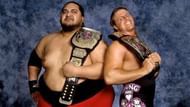
Owen Hart was the King of Harts, a two-time Slammy Award winner, and the greatest at turning storyline garbage into pro wrestling gold.
Each of his three highest-profile tag teams shared two things in common: they seemed thrown together out of a lack of other options and they led Hart to tag team gold.
Entering WrestleMania XI, Owen had challenged Billy and Bart Gunn, a.k.a. The Smokin' Gunns, a very traditional team in WWF terms, to a tag team championship match. Hart promised he would have a mystery partner, who turned out to be the man who wrestled twice on the previous year's show, and both times for the WWF Championship, Yokozuna. Following a casket match loss to The Undertaker at 1994's Survivor Series, Yoko took a company-prescribed break to try to control his massive weight, and his WrestleMania match was the big man's first WWF sighting in months.
Owen and Yoko steamrolled the Gunns, holding the belts until September, before going their separate ways with a Yokozuna babyface turn and subsequent feud with former manager Jim Cornette (still aligned with Hart).
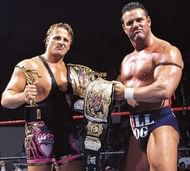
Cornette brought Hart's brother-in-law Davey Boy Smith into his heel camp in late 1995, managing The British Bulldog to consecutive pay-per-view main even title shots against Shawn Michaels in May and June of 1996; the latter match had Owen Hart on commentary, whose blatant partisanship for his family (by marriage and by manager) led to an onscreen pairing which captured the WWF Tag Team Championships from, once again, The Smokin' Gunns in September of that year.
Holding the belts into May of 1997, at one point the in-laws controlled both of the midcard men's titles as well, bringing both the European and Intercontinental Championships to the Hart Foundation before entering singles runs (though still part of their anti-American faction) over the summer.
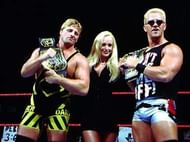
Hart ended his career (and, unfortunately, his life) teaming with Jeff Jarrett; starting in 1998, the duo were originally to have coalesced over an Owen-Debra affair which was nixed by the Slammy Award-winner. Jarrett and Hart's friendship on and offscreen led to Hart's final tag team title reign, holding the belts from January of 1999 until just after WrestleMania that year.
Jarrett's time with Owen was short-lived, but led to a deep offscreen connection and making Jarrett one of the most visibly shaken superstars on the Monday Night Raw paying tribute to Owen's life in May of 1999.
#5 Tyson Kidd and Cesaro
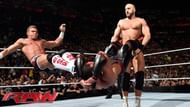
Kidd and Cesaro are another thrown-together team whose success was tragically cut short (although not to the extent of Owen Hart and Jeff Jarrett).
Lasting just a few months in the spotlight, Kiddaro formed in December of 2014 with both men finding little success in WWE's crowded midcard (though, to be fair, with WWE World Champion Brock Lesnar off television, everything in late 2014 was the midcard).
The tandem quickly got over with their combined technical style and highly entertaining tandem moves, like combining Cesaro's crowd-pleasing Big Swing with a vicious Kidd basement dropkick. They also brought fans into their well-speculated backstage positioning, wearing custom-made "Brass Ring Club" gear to the ring in January with short-lived ally Adam Rose; the gear featured a parody of the Bullet Club logo which played on Vince McMahon's favorite phrase of "grabbing the brass ring," referring to his preference for superstars who forced their own success by seizing every opportunity onscreen and being vocal about their desires offscreen.
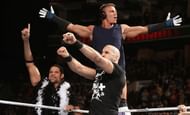
Kidd and Cesaro won their only tag team gold in February of 2015 at Fastlane, holding the belts until losing them to The New Day at Payback in the spring; their last pay-per-view pairing came at Elimination Chamber, where they failed to leave the first-ever tag team Elimination Chamber match two-time champs.
Tyson Kidd found himself acting as enhancement talent for recent signee Samoa Joe when Joe's signature Muscle Buster maneuver left the former Dungeon trainee severely injured; Kidd has not wrestled since, and his career looks to be over, unfortunately.
#4 Team Hell No
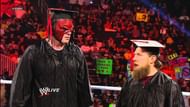
Team Hell No had a similar start as The Bar, with an odd couple pairing growing out of an intense rivalry involving AJ Lee, jealousy, championship frustrations, and, worst of all, early 20-teens Charlie Sheen.
Daniel Bryan and Kane's mutual frustrations at their failure to recapture world championships landed the pair in anger management, where an overzealous Dr. Shelby forced the two into an awkward tag team pairing that captured the tag titles in late 2012.
As ridiculous as their origin story sounds, Kane is and always has been the consummate company man, and put a great deal of effort into making the angle succeed. Bryan, meanwhile, committed wholeheartedly to the angle's comedic elements (much like the "vegan" story that netted the leader of the Yes! Movement his eventual wife).
Team Hell No quickly coalesced not just in their desire to succeed, but in their mutual hatred of Dr. Shelby, who seemed to be modeled after Metallica's far-too-involved group therapist from the documentary Some Kind of Monster.
Team Hell No went from strange beginnings to a 245-day tag title reign, which spanned a classic TLC clash against The Shield, as well as another memorable Shield match where Team Hell No aligned themselves with The Undertaker, and for which Bryan had diagrams!
#3 The New Day
For as much as they are mentioned in this list with their involvement in the WWE Tag Team Championship scene, The New Day was put together in late 2014 as a last-ditch effort to find a meaningful storyline for Kofi Kingston, Big E Langston, and NXT alumnus Xavier Woods.
Each man was a solid worker and a decent promo, but hadn't gotten the spark to truly shine in WWE prime time; the New Day grouping was one that seemed doomed from the very start.
Fans lambasted it for being an apparent knockoff of the Nation of Domination (the three men being African American and their use of African American cultural imagery in their early vignettes seemed like a rehash of the late-1990s Black Power storyline), for maybe being just a touch racist (with their gospel entrance music, choir promos, and preacher voices, not to mention the fact that WWE had very few Black performers at the time, and teamed up three of them), and for being just plain cheesy (WrestleMania 31's live crowd was vicious and merciless in their booing and chanting against The New Day and their over-the-top playing to the crowd).
Little did we know that Vince McMahon was traveling a road he'd once traveled by accident, but this time making his way down it purposefully: like the way he'd attempted to make Rocky Maivia the defining babyface of the 1990s by forcing him to smile and clap at all times, McMahon let The New Day alienate crowds nationwide with their cheesy smiles and silly claps, leading to a post-Mania heel turn that, coupled with a tag title win, elevated New Day into the stratosphere.
Like many of the other teams on this list, New Day benefitted most from two things: freedom to experiment and onscreen time with which to do it. Simply letting the three men improvise jabs (at opponents and each other), embrace internet memes, and play around with their look has led to classic merchandising opportunities like Booty-O's Cereal and any number of brightly-colored unicorn shirts, as well as one of the most enjoyable crowd participation introductions since the Attitude Era.
#2 The Acolytes
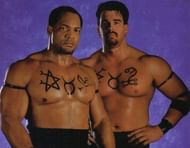
By the summer of 1998, two of WWF's once-hottest prospects had found themselves languishing on the back burner: former WCW World Champion Ron Simmons, now known as Farooq, and Bradshaw, formerly Justin "Hawk" and/or Blackjack Bradshaw.
Bradshaw had been a heavy hitter Texas stereotype since early 1996; he was The Undertaker's Victim of the Night on the WrestleMania XII fallout show when Mankind attacked The Deadman to kick off one of the greatest feuds in wrestling history. WWF tried repackaging him as 1996 led on to 1997 with Barry Windham as a rehash of an old tag team that hadn't been popular in most fans' lifetimes at that point.
Faarooq, meanwhile, was a former Florida State University standout in football who became the first Black wrestler to win a major company's world title in the early 1990s when he became The Man in World Championship Wrestling; upon joining the WWF in 1996, he showed up in an ugly gladiator-themed costume managed, nonsensically, by Sunny.
The gimmick was abandoned quickly until Faarooq became a Malcolm X/Louis Farrakhan-type figure and formed his own faction in the Nation of Domination, recruiting Crush, Savio Vega, and an army of independent and developmental talent to accompany him to the ring. The group evicted its non-Black member is mid-1997, kicking off a three-way gang war and making room for Kama Mustafa (the future Godfather), Mark Henry, and the recently-heel Rocky Maivia. Maivia's star very soon eclipsed Faarooq, who found himself losing his spot to the man now known as The Rock in the spring of 1998.
With the bump from the Ministry, The Acolytes went from forgotten New Generation relics to veritable Mortal Kombat bosses, decimating nearly every team in the World Wrestling Federation en route to three WWF Tag Team Championships.By November of 1998, the two were mostly forgotten victims of Attitude Era trainwreck storytelling, until they reappeared together in matching black gear to attack the Disciples of Apocalypse on RAW. The Jackyl (a.k.a. Don Callis) proclaimed them his Acolytes, but Callis's eventual departure led to the Acolytes' eventual alignment with The Undertaker and his Ministry of Darkness; the duo was a perfect fit as mysterious runes and vaguely occult imagery, in addition to brutal kayfabe violence, had been part of their defining characteristics since their repackaging.
The pairing continued to evolve throughout the Attitude Era, shedding their demonic roots to become a hard-drinking private security company (and, of course, one of them found a little bit of success after that, too).
#1 The New Age Outlaws

Oh, you didn't know that the Outlaws were a thrown-together team? You just better call your Internet provider so you can use the WWE Network to re-watch Monday Night Raw in the spring of 1997 to see the feud between Billy Gunn and Jesse James which led to a seemingly-doomed summer pairing.
Rather, don't, as the two men feuded first over who would "get" to have Honky Tonk Man provide his managerial services, then continue to battle over the fact that Honky turned on heir apparent Jesse James, a.k.a. "The Real Double J," so named because he was revealed to be the true singer of "With My Baby Tonight" in a Milli Vanilli-inspired angle.
Gunn, in winning Honky's services, was redubbed "Rockabilly" heading into the summer of 1997, and then...nothing. James and Gunn were lost in the shuffle of WWF focusing on The Hart Foundation, Steve Austin, The Undertaker, and the impending invasion of his long-lost brother, Kane.
In October 1997, Gunn and James's pairing came down to the latter simply suggesting that their careers were going nowhere and they might as well team up; Rockabilly's response was to smash a guitar over his now-former mentor's head in an ode to Honky Tonk Man's favorite form of assault in the 1980s.
From that point on, The New Age Outlaws' heel antics, sing-along entrance, and embracing of pop culture phenomena like South Park helped cement the Attitude Era staple of the "cool heel" brought on by Steve Austin the previous year; from that point on, the Outlaws captured five WWF Tag Team Championships (and a WWE Tag Title in a brief nostalgia run as part of the Authority storyline during The Shield's babyface turn), becoming onscreen and front-office staples in the process.
What makes Sting special? His first AEW opponent opens up RIGHT HERE.
